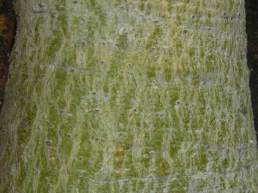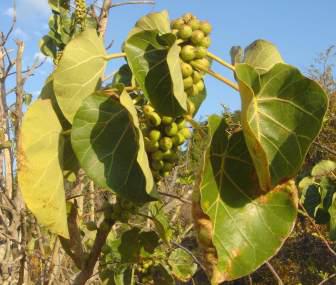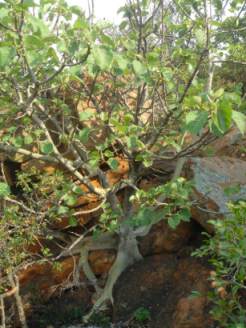Ficus abutilifolia
Ficus abutilifolia (Miq.) Miq.
Family: Moraceae
Common names: large-leaved rock fig, rock wild fig (Eng.); grootblaarrotsvy, klipvy (Afr.); inkokhokho, impayi, ubambematsheni (Zulu); momelantsweng (Tswana); tshikululu (Venda); amphayi (Thonga); monokane (North Sotho)
SA Tree No: 63
Introduction
The conspicuous white to yellow roots and stems of the large-leaved rock fig are an impressive sight, well adapted to hugging rock faces and splitting rocks and earning this species a place among the true rock-splitting figs.

Description
Description
Ficus abutilifolia is a small to medium-sized, deciduous to semi-deciduous tree up to 15 m high, though it seldom exceeds 5 m. The bark is whitish to yellowish white and smooth, powdery or somewhat flaking, and it is this conspicuous bark that is immediately apparent. The trunk is usually twisted or contorted, the branchlets stout and glabrous (lacking hairs) and marked with leaf and stipular scars.

The leaves are broadly ovate and heart-shaped to almost round and are cordate at the base, ranging in size from 75-200 x 65-180 mm. They are glabrous on both surfaces, occasionally with velvety hairs beneath, with 4-9 pairs of secondary veins, entire wavy margins and a petiole up to 120 mm long.

The fruit, which are 15-25 mm in diameter, are borne singly or in pairs in the leaf axils on terminal branchlets, and are smooth to slightly hairy. They may be sessile or on short, stout stalks up to 15 mm long and are green becoming yellow or red when ripe. Read more about what is unusual about fig fruits and their pollination on the Ficus trichopoda page.
Ficus abutilifolia is a fairly distinct species but does resemble F. tettensis and F. glumosa which are readily distinguished by their smaller, hairy leaves and hairy branchlets.
Conservation Status
Status
Ficus abutilifolia is not currently recognized as a threatened species.
Distribution and habitat
Distribution description
The large-leaved rock fig is generally encountered on rocky hillsides, rocky outcrops and along streams. The species is always found on or near rock outcrops (Burrows & Burrows 2003), and while it is often found on granite, it grows also on sandstones, basalts and ironstone. The altitudinal range is from sea level to around 1000 m and although able to tolerate light frost, it enjoys lower altitudes and hotter conditions. It is restricted to the African continent and here it has a widespread distribution, occurring in the South African provinces of KwaZulu-Natal, Mpumalanga, Gauteng, and the North-West up into Mozambique, Zimbabwe, Botswana, Namibia, Malawi, Zambia, Ethiopia, Somalia and west to Guinea.
Derivation of name and historical aspects
History
The species name abutilifolia stems from the resemblance of its leaves to those of Abutilon, a popular ornamental genus (Burrows & Burrows 2003). The very apt Tswana name momelantsweng translates as 'cling to rock' (Palmer & Pitman 1972). It is from the Latin word ficus, which refers to both to the fig tree and the fig, that the generic name Ficus is derived (Burrows & Burrows 2003). The genus Ficus is found throughout the tropical and subtropical regions of the world and is comprised of between 750 and 800 species. The greatest concentration of figs is found in SE Asia, numbering approximately 500 species, with roughly 100 species occurring on the African continent. The southern African region is home to 48 of these.
The genus belongs to the relatively large Moraceae family, comprising a total of 37 genera and roughly 1 100 species. Features characteristic of the family include the presence of a latex (often milky), stipules serving as apical bud sheaths, unisexual flowers and simple leaves. Notable members of the Moraceae include the well-known mulberry (Morus alba) and the common fig ( Ficus carica ), both having been in cultivation since early times.

Ecology
Ecology
As mentioned, Ficus abutilifolia is a species most commonly associated with rocky outcrops and relatively hot and dry conditions. The ability of the roots to reach great depths of up to 60 m and that these may reach sources of underground water, has been recorded. This species is one of a few South African rock-splitting figs which include F. cordata, F. glumosa, F. ilicina, F. ingens and F. tettensis. Pollination of flowers within the receptacles is carried out by tiny wasps which enter through the ostiole, a small opening at the tip of the receptacle. Two wasp species presently known to effect pollination in F. abutilifolia are Elisabethiella comptoni and Nigeriella fusciceps, recorded from Malawi and Nigeria respectively (Burrows & Burrows 2003). The tasty fruits are enjoyed by people, and by a host of birds, fruit bats, monkeys and baboons, bushbuck, bushpig, duiker, klipspringer, nyala and warthog.
Uses
Use
The uses for Ficus abutilifolia so far documented are somewhat limited and mostly medicinal in nature. The wood is light and soft, yet tough (Burrows & Burrows 2003); it becomes a yellow-brown when dry and works easily and polishes well but on the whole it is not of much use to people. Decoctions prepared from the leaves are used in promoting fertility in humans and good crop yields, and the milky latex derived from the plant is used to remove skin warts (Ellis 2001). In addition, bark decoctions are taken by men as a strengthening tonic (Hutchings 1996). Though it is not much used in horticulture as yet, it shows great potential, and is known to be a good subject for bonsai.
Growing Ficus abutilifolia
Grow
The large-leaved rock fig is best grown from seed. The fruits should be collected when soft and ripe, and opened to allow them to dry for a day or two. The sieved seeds or crumbled up desiccated fruits can then be distributed over the surface of the growing medium and covered lightly with this same medium, a recommended one being equal parts of washed river sand and vermiculite mix. Sow in spring. Seedling trays with a depth of 70 mm are recommended for sowing. Germination can be expected between 10 days to a month from sowing depending on temperature and the freshness of the seed-fresh seed and warm temperatures will favour more rapid germination. Place the trays in a warm, well-lit and ventilated position and keep moist, and preferably treat with a fungicide such as Captan to reduce the occurrence of fungal problems. Seedlings should be placed in a sunny position and eventually transplanted into a well-drained sandy mix rich in organic matter.
Cuttings are an alternative method to seed sowing although this species does not root as readily as some of the other fig species. According to Ernst van Jaarsveld (pers comm.) it is best to take softwood or semi-hardwood cuttings in spring, around 200-250 mm long. Remove the lower leaves from the stem. Insert into a washed river sand mix and place in a misting unit, or if this is not available, place the tray with cuttings inside a clear plastic bag to reduce the adverse effects of transpiration. These should root within a month and be ready for transplanting in a further 3-4 weeks into a rich, well-drained medium. This attractive and interesting species certainly deserves more recognition in horticultural and gardening circles. It makes a fine showy subject planted among rocks in the garden, or on old walls and similar unwanted structures, where its pale spreading roots and rounded crown can create quite a feature. Beware though to avoid close proximity to plumbing, sewerage, pools and buildings. F. abutilifolia will reward you with an abundance of wildlife and a marvellous exhibition of nature.
References
- Allaby, M. 1998. A dictionary of plant sciences. Oxford University Press, Oxford.
- Burrows, J. & Burrows, S. 2003. Figs of southern and south-central Africa. Umdaus Press, Hatfield.
- Coates Palgrave, M. 2002. Keith Coates Palgrave Trees of southern Africa, edn 3. Struik, Cape Town.
- Hutchings, A. 1996. Zulu medicinal plants: an inventory. University of Natal Press, Pietermaritzburg.
- Palmer, E. & Pitman, N. 1972. Trees of southern Africa, 3 vols. Balkema, Cape Town.
- Pooley, E. 1993. The complete field guide to trees of Natal, Zululand and Transkei. Natal Flora Publications Trust, Durban.
- Van Wyk, A.E. (Braam) & Van Wyk, P. 1997. Field guide to trees of southern Africa. Struik, Cape Town.
- Von Breitenbach, F. 1965. The indigenous trees of southern Africa. Department of Forestry, Pretoria.
Credits
Jan Burring
Pretoria National Botanical Garden
November 2006
Plant Attributes:
Plant Type: Tree
SA Distribution: Gauteng, KwaZulu-Natal, Limpopo, Mpumalanga, North West
Soil type: Clay, Loam
Flowering season: Early Summer
PH: Acid, Alkaline, Neutral
Flower colour:
Aspect: Full Sun
Gardening skill: Easy
Special Features:
Horticultural zones









Rate this article
Article well written and informative
Rate this plant
Is this an interesting plant?
Login to add your Comment
Back to topNot registered yet? Click here to register.